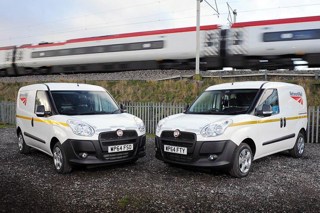As the industry prepares to take a well-earned seasonal break it is fair to say that 2018 has been a rollercoaster journey for the new van market with as many months seeing sales rise as there were months where sales fell.
After the 6.1% decline in new light commercial vehicle (LCV) in September which was 3,520 less vans, October shot up by 3,526 LCVs as the market rose 14.1%, totally recovering September’s deficit.
By the end of October, the UK LCV market was down just 1.6% in 2018 with 302,741 new LCVs registered. This puts the UK on track to exceed the 350,000 mark for the whole year.
The growth in online shopping is continuing to drive demand, particularly for larger LCVs in the 2.5t-3.5t group which accounted for 63% of all new LCV sales in 2018, one percentage point up on 2017.
If the new van market has been a rollercoaster the used LCV market has been more like that 1988 hit by Yazz and the Plastic Population, The Only Way Is Up, as used LCV prices broke record after record each month.
Stuart Pearson, chief operating officer for UK remarketing at BCA, said: “As we have reported consistently throughout this year, the LCV market at BCA has seen continued growth.”
BCA reported the average LCV sales price rose to 8.4% (£7,324) in October even though the average mileage went up by 2.9% to 69,651, with average age dropping only by 0.69 a month.
Part of the reason why values are continuing to rise is the changes coming in 2019, including London’s Ultra-Low Emission Zone (ULEZ), the clean air zones (CAZs) in other parts of the country, Brexit and not forgetting the September 1, 2019, introduction of WLTP for LCVs.
In fact, the demand for Euro 6 vans is so strong it is pushing up prices to the point where they are almost competing with heavily discounted new vans.
BCA noted that nearly-new LCVs rose by 3.8% compared with October 2018.

Both Glass’s and Cap HPI also commented on how demand is outstripping supply for vans which can meet these CAZ restrictions to the extent that prices are rocketing upwards.
Andy Picton, chief commercial vehicle editor at Glass’s reported buyers are having to pay “10% more on average over this period” putting the blame on a shortage of good quality used supply. Picton also said that, as at BCA, this was despite the average age increasing and the average mileage going up by more than 2,600 miles.
While Cap HPI said that October saw a particularly high increase in used LCV sales it also believes that shortages in supply are creeping in which will continue to drive prices upwards for all van sectors, irrespective of condition.
Ken Brown, Cap HPI Red Book editor – light commercial vehicles & motorhomes, said: “We’ve witnessed many examples of professional buyers paying well above guide price for vehicles that were exhibiting significant amounts of damage, particularly in the medium and large van sectors.”
It therefore comes as no surprise that the higher prices and shortages in supply are also resulting in higher conversion rates with Picton noting a four-month successive rate of growth in first-time conversions peaking at 82.9% for October.
There seems to be no divergence in sales success between vendor types either with BCA saying that both corporate and dealer sales are doing well and achieving “excellent conversion rates”.
According to BCA, the fleet and leasing sector saw its fourth highest value on record in October in the face of rising mileages and ages which makes the 6.9% year-on-year growth even more remarkable.
Dealer part-exchange vans did even better as they rose by 4.6% to £4,621, the second highest on record, even though average mileage went up by almost 7,000 miles.
Online sales also continue to grow with BCA reporting that “many vendor sections (are) now selling 50% of stock to BCA Live Online bidders”.
Retail shopping is not just helping to keep some momentum in new van sales, it is also helping underpin demand in the used market.
Tim Spencer, LCV sales manager at Shoreham Vehicle Auctions (SVA), reported that “many small businesses or owner operators (are) replacing their vehicles ready for a busy few weeks delivering the billion of pounds-worth of goods consumers have bought online for Xmas”.
We also see trade buyers snapping up stock ready to meet the usually busy period at the start of the year when small businesses often look to refresh their fleets, compounding the supply and demand issue.
But fleet operators are not just looking at the need to fulfil the seasonal shopping demand. They are also only too aware that we are now facing some cold and wintry months ahead and that means the usual uplift in demand and prices for 4x4s which has been reported by both trade guides.
Cap HPI said that not only was demand strong for the 4x4 workhorse pick-ups but that there was increasing trade demand for 4x4 lifestyle pick-ups.

Picton also noted that in the 4x4 segment it was those with the highest specification and “ideally with automatic gearboxes” which were performing well.
This demand for lifestyle commercial vehicles with good specification is worth noting in conjunction with the constant reminder about the rise in online shopping resulting in increasing demand for LCVs, new and used.
A lot of the couriers are self-employed, and their van may also have to be the family vehicle, something Picton noted by the demand for crew cabs.
According to SVA’s Spencer, “small businesses are increasingly looking for a used van that makes an impact when they are on the road or parked at a customer’s house”.
He added that SVA has noticed how demand for coloured vans is very much on the increase with a premium of £500 being paid over an identical age, mileage and condition white van.
That is pretty much another year over and I think it has been the year of the used van with rocketing sales and prices. But what can we expect for 2019?
Quarter one is likely to see a flurry of interest in the used van sector, while the new LCV market remains on a watching brief as we face Brexit on March 29 followed by the introduction of London’s ULEZ on April 8.
Heading through quarter two and three, the wider introduction of the Worldwide harmonised Light vehicle Test Procedure (WLTP) is set to see a lot of push in the new LCV market as OEMs carry out similar actions they used in the car market a year earlier and fleet operators look to take advantage of some of the enticing offers that will inevitably be available.
This means we may well see a shortage of certain new vans from September onwards so if you operate your own fleet and are considering when to make the change keep this in mind.
The need to keep the retail and business wheels turning despite this uncertainty in the new van market should be good news once again for used van vendors so let’s raise a toast to that and pass around the mince pies.
By Dean Bowkett

















Login to comment
Comments
No comments have been made yet.